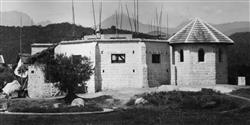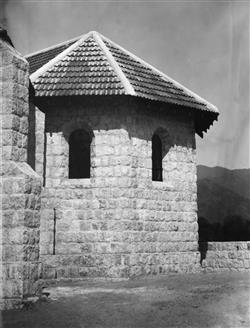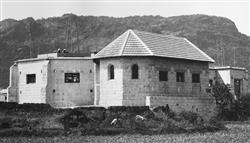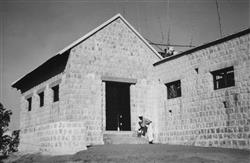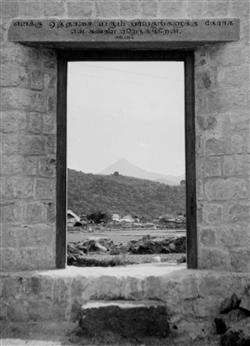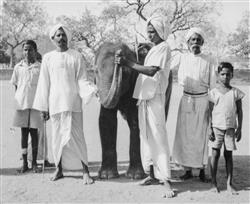Report of the REVD.
Missionary at Nazareth, Tinnevelly
Full Postal Address, S.P.G., Nazareth, S.I.R., S. India
REPORT FOR THE SIX MONTHS ENDED 31st MARCH 1942
THE ART INDUSTRIAL SCHOOL
GENERAL
The word ‘progress’ best expresses the work of the Art Industrial School, Nazareth, during the last six months - the period covered by this Report. Beyond this there seems little to say. The school is like a piece of smooth-running machinery which, provided it is kept well oiled (as the school has been with a constant stream of orders), continues to run smoothly and gives little or no trouble.
There Is no doubt that the school needs European management and will need such management for many years to come. I do not make this statement by way of disparagement of my Indian colleague - who is an excellent fellow in every way, nor in praise of my own personal management of the school. One has only to call to mind how quickly the school went downhill in the interim of 1936-38 when under Indian management. The general public, European and Indian alike, places far more confidence in such an institution as the A.I.S. when it knows that it is under European management.
CURRENT WORK
During the last six months the school has been kept continuously busy with several spells of overtime. Work for Roman Catholics has constituted about one third of orders received. I find that they are extremely pleasant to deal with and far more appreciative of what we do than are members of our denomination. We have completed the Canons’ and Archdeacon's Stalls and the Bishop's Throne in Palamcottah Cathedral. Our finances (not that we have money and to spare) made it possible for us to make the Bishop's Throne a gift from the Art Industrial School.
Of outside work by far the most important is the Chapel of the American School (High Clerc) at Kodaikanal. Work on this has brought the building to ground level which, considering the difficulties of the steeply sloping site, is very good progress. Because of war uncertainties the work is being suspended till the close of hostilities. Enough work has been built to give a good idea of what the future building will be.
Steady progress has been maintained in the building of the parish church at Vickramasingapuram [Saint Peter's]. In effect this is a double church - a large aisled church with an ambulatory to the apsidal sanctuary, and a smaller church in the form of a side chapel to the north joining the north aisle for half its length. It is hoped that this arrangement will meet the needs of the Tamil mills' workers as well as those of the European staffs of Messrs. A. & F. Harvey Cotton Mills and of the Hydro-Electric Station now being built at Papanasam, two miles away. The enclosed photographs [below], taken in March 1942, show that the side chapel has been completed.
The church is a still further development of what I was able to do at the chapel of Bishop's Theological College, Tirumaralyur, at the parish church at Oyangudi and at the Chapel of St. John's College, Palamcottah. It is a most interesting exercise in the use of local architecture and of the exclusion of all that is "churchly" or "gothic" (or foreign) In design. The stone is a white granite, some of it quarried on the site. As the photographs show, the church lies at the foot of the mountains. By way of a gesture to local thought I have lined the church on to a peak regarded as sacred by the Hindus.
[The peak Agasthyamalai through the "west" window.]
This has given pleasure to both Hindus and Christians while the deviation from due east and west is only very little. Funds are urgently needed to complete the work - I wonder if there is anyone at home who is interested in 'indigenization' who would care to sponsor the scheme.
I have refused two recent requests to prepare plans for churches. In both cases donors had stipulated that the designs must be gothic.
MISCELLANEOUS
The health of the school has been good on the whole, though a case of leprosy was recently brought to light. This, together with two "heart" cases both following an earlier history of rheumatic fever, has decided me to have all now boys thoroughly examined medically before admission. Hitherto the practice has been to merely accept the statement of the recommender that the boy's health is good and to admit without any examination. Nine boys were baptized in September last and fifteen were confirmed in March of this year.
It was a great pleasure and privilege to me to act as host to three Bishops and a Canon during the week of the Nazareth Convention, last February. The enclosed photograph shows the A.I.S. Staff with two of its guests, Bishop Sandegren (Lutheran Bishop of Tranquebar) and Bishop Neill. Bishop Azariah and Canon Selwyn were not available for the photograph otherwise they too would have appeared.
The other photograph [above] of my bungalow staff has its interest. The old gentleman [‘Moses’] [on the right] is one of the original famine orphans taken in by Canon Margoschis and is now my butler.
Unpleasantness over property enjoyed by the Mission still continues. This time it is not the headmaster of the Boys' High School who is making trouble but the president of the Nazareth Panchayat Board (or Chairman of the Urban District Council as we should describe him in England). This gentleman wishes to bring the public highway right through the mission compound. I am opposing the scheme. As the matter is far from settled at the present time, I will say no more about it in this Report.
Copies of our printed Report for 1941-42 are enclosed. This Report will supplement what I have stated here.
Nazareth, Tinnevelly, S. India.
7th April 1942
